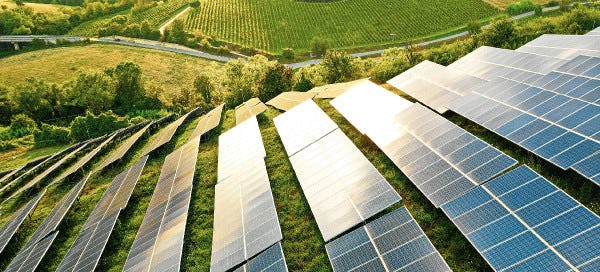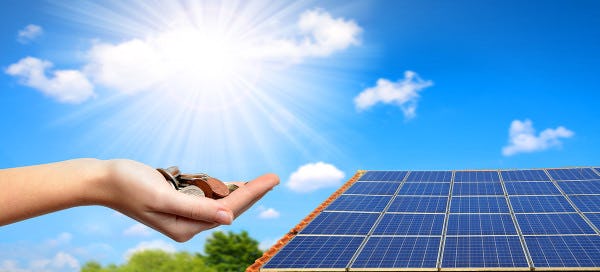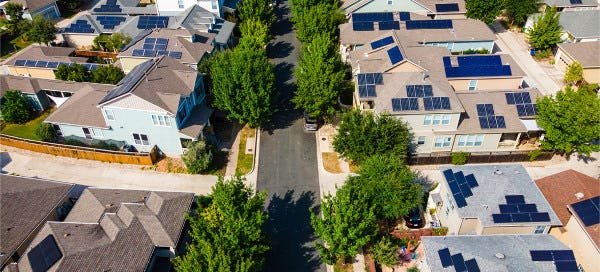My name is Alex Bobrek and I’m a Data Scientist with 15 years of experience in the Energy sector. Recently, I went solar with Rhythm Energy, a renewable energy provider in Texas. When it comes to the decision of whether to install rooftop solar panels on my own home, you would think that would make me a very informed shopper. However, I am relatively new to this industry, and although I have many years of experience with data, analysis, and modeling investment decisions, I had to research this one from scratch. To start, I read a bunch of articles on the internet on solar topics and I talked to coworkers that have spent decades in electric utilities in order to understand fundamental industry trends. In the end, what taught me the most is to simply dive into the numbers, do some detailed economic analysis, and draw my own conclusions. During this process, I learned a few things that were key to my decision, yet I did not find them discussed much in solar articles on the internet, and certainly not addressed by some of the solar marketing messages out there. I’m hoping that you will find my story and experience valuable if you’re considering a solar installation of your own.
First, a bit about me. My family lives in a 4200 sq. ft., two-story, eight-year-old home in the Oak Forest neighborhood in Houston. We have two boys, ages 10 and 12, and we’re thinking we’ll be staying in this home until at least our boys finish high school. As solar panels are a large financial decision with a long payback timeline, it is important to have a new enough roof and a personal family situation that supplies enough runway to reap the benefits of this decision.
Although I started looking at solar because I feel strongly about the environment and energy independence (and am a bit of an early adopter geek), making the actual decision to purchase in our family was very much driven by economics. Even if your primary reasons for solar are driven by things like environmental impact or energy independence, economics should drive the details of how your system should be sized and designed, and are therefore worth paying attention to. I will break up my journey into several sections, because there’s a lot I want to share. Each section offers a key learning that I felt was important in how I configured my system:
How knowing my energy usage was key in selecting the optimal system size for me.
How transition to more renewables is changing the economics of home solar, and why I decided that pairing solar panels with home batteries was a must.
How I decided to focus less on selling my excess energy back, and more on finding good Time of Use plans that maximize the value of my home batteries (with some bonus content on how to best make EVs work with your solar).
How I approached the financing decision and how my installation process went.
Knowing my energy usage and how it changes throughout the year was key in selecting the optimal system for me
This is where I get a bit of a benefit from my day job. Part of what we do in the Rhythm Data Science group is to try to understand how people use their energy so we can create the best energy products to serve their needs. Once you have access to many thousands of households of electricity usage data you realize that there are significant differences in usage patterns between different households. It’s very important to know your own usage because you don’t want a too big of a solar system (you’re wasting money buying panels you’re not fully using) or too small of a system (you’re paying fixed installation costs but not taking full advantage of as many solar panels as you can). If you’re in Texas, the easiest way to see what your usage is to use the Smart Meter Texas website, which has your usage down to the 15-minute intervals.
Perhaps the biggest surprise to me once I looked at the data was the seasonal variations in usage. For example, my home uses ~2-3 times more energy in the summer than in the winter, as we have gas heating. Therefore, I’m faced with a choice: if I select enough solar panels to cover my summer usage, then I’m significantly over-generating in the sunny spring/fall months; but, if I size it for spring/fall, I will have to buy a lot of energy from the grid to cover the difference.
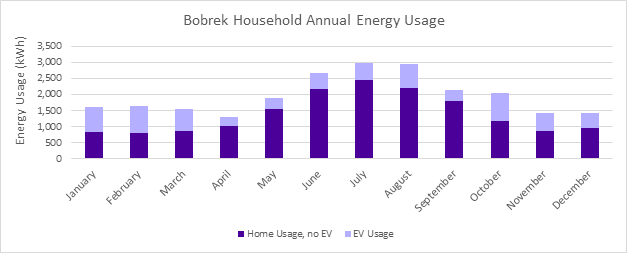
But you might say: “Alex, can’t I sell my excess generation back to the utility for those times I’m over-generating?” The answer is yes you can, but at what price? I will get more into this in the next section, but I believe (and the data is showing) that as more solar is built out, the value of electricity during sunny hours is rapidly falling due to the abundance of electricity supply at those times. In a future where there are a lot more commercial and residential solar panels in service, at times your home is generating more solar than it needs, so is everyone else’s. Because of this oversupply, I believe you’re unlikely to get the same average price for energy you buy vs energy you sell, but more on that in a subsequent section…
In the end, I decided to size my solar panels to roughly cover about 60-70% of my total electricity usage in the summer, because I found that as I started to add more panels, the costs were going up and the value of selling the excess energy in spring/fall was not offsetting those costs.
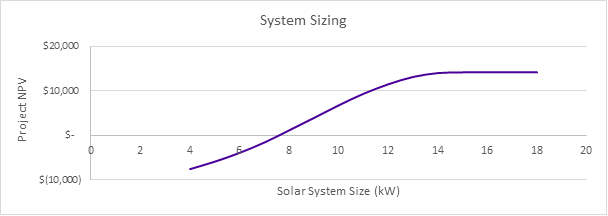
The graph above roughly illustrates this behavior, comparing the final value of the investment with system size. Note how once my system reaches 14kW, adding more panels increases my cost, but doesn’t really provide me with any more value. I extended the graph further beyond 18kW, the value would start going down as investment in more panels would generate even more electricity I couldn’t use.
One final note: in my usage graph you noticed that I have an EV. I chose to size my solar panels to cover only the usage of my house instead of house + EV. Why? I didn’t think I was going to be at home enough during the sunny hours to be able to regularly plug in my EV to charge; instead, my plan is to look for Time of Use electricity plans with cheap overnight rates for my EV. More on this in a subsequent section when I’ll talk about what kind of electricity plan(s) I want to pair with my solar install.
There are a ton of assumptions that go into the analysis above that I won’t get into, but I hope you get the general idea. The conclusions I would like to leave you with are:
Sizing your system to your actual usage is very important to the value you get out of your solar panels. Everyone’s home is different: it may have better/worse insulation, newer/older AC systems, electric heat, pool pump, etc. There are many websites that have solar calculators that can help you understand roughly the size of the system they recommend. I suggest you run multiple of them to compare the results. Alternatively, utilize a solar design/concierge service that can customize the system to your needs. that can customize the system to your needs.
Be wary of statements like “never get another electricity bill again”. Could you build a big enough solar system for this to be true? Absolutely. Is it a good financial idea? Absolutely not. My personal experience has been that online calculators I’ve tried have generally tried to sell me more solar panels than my own analysis suggested, however your mileage may vary. Be prepared to still buy some of your energy from the grid.
The world is changing as more solar is added to the energy mix; a.k.a. why my solar system needs batteries
In the previous section I briefly mentioned that I don’t believe that receiving the same (average) rate for electricity you buy and electricity you generate is sustainable in the long term. Let’s get into more detail why this is, because this topic drove my decision to pair my solar panels with a home battery system, and why I think that all residential solar installs should be paired with batteries.
First a little bit of background: although you might be paying a predictable electricity rate from your electricity company, the actual price of electricity goes up and down based on supply and demand and can be quite volatile. To give you a single flat rate, your electricity company estimates your usage, estimates how the prices will change throughout the day, and sets a fixed price that covers the cost of your energy on average across the length of your contract. On any given day, your electricity company might make money off you or lose money on you, but across the entire year, it should generally average out. If you are getting a fixed price for selling back your solar generation (called net metering in some states or solar buyback in Texas), the same process should hold: the price you get should be a function of the time of day you sell your energy and the price at that time. This is very important, so I will say it again: the time of day you sell your energy is key to the price you should expect to get.
Generally, electricity prices have been cheap overnight due to low usage and more expensive during the day, especially in the hot summer months when there’s a lot of A/C usage. However, as more solar power is being added to the grid, this pattern is shifting. There is no easy way to store electricity, so any area with a large amount of solar will start seeing more energy supply available when it’s sunny. The graph below shows change in California’s net load from 2015 to 2023; notice how each year as more solar is added to the grid, there is less and less net load during the middle of the day, making energy more plentiful and prices lower. This phenomenon has been called the “duck curve” because it kind of…well…looks like a duck. Quack, quack!
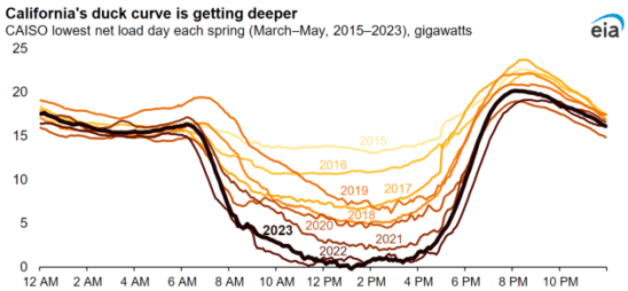
Source: US Energy Information Administration Okay, so that is California, so why is it relevant to us in Texas? Here’s a graph that shows the amount of solar power installed in the state of Texas vs other states. Where California’s solar additions have been relatively steady, Texas has grown (and looks to continue to grow) much faster, meaning that the duck curve above that has taken 7 years in California to materialize might take half that time in Texas.
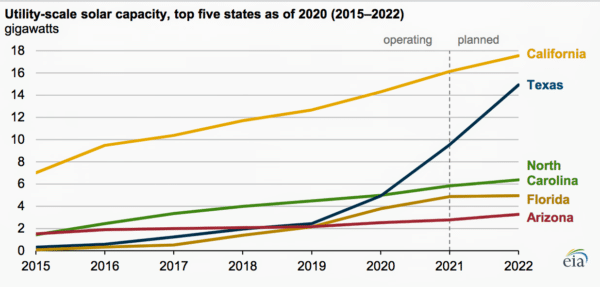
Source: US Energy Information Administration
So, what does this all mean for me as a solar owner? Even though at the time of this writing, there are still annual contracts in Texas that will pay 1:1 ratio for energy you buy and energy you sell, and although they are a great deal for the homeowner, they cannot last. Remember, this is an investment with a multi-year payback time, which is why I was not comfortable assuming a high buyback for entirety of my solar investment. Unless you have home batteries, you are likely to sell back your energy during solar oversupply hours meaning that your energy will not be worth that much. Electric companies in Texas will eventually price this change in, and looking at the trend in solar buyback plans out there, the movement has already started.
For the above reasons, I chose to pair my solar system with home batteries, and I highly recommend it for everyone else. Batteries allow me to store my excess solar energy well into the evening hours during summer months and should allow me to be exclusively grid free during sunny but more moderate weather in spring and fall. I don’t have to rely on getting a high buyback price for my energy during the day. Instead, I can use Time of Use plans that pay me different rates throughout the day, allowing me to shift my usage to cover expensive price periods and use the grid only when the rates are cheap. Using the assumptions I shared above, solar + battery configuration consistently outperformed solar-only economics in my analysis.
Although I believe batteries are a good financial investment, energy independence and whole home backup that batteries bring are also a nice side effect. The way I’ve sized my system, I should be able to indefinitely run my whole house without using the grid in moderate temperatures and get several days of backup during summer with careful A/C usage. Where some of my neighbors have spent $10k+ to install gas powered generators that rarely get used, I feel home backup system with solar + battery is a great value on top of the daily economic benefit the system brings. The conclusions I would like to leave you with are:
Batteries are key to getting the most economic value from your solar system. They give you flexibility to choose when you use the grid (if at all), and can also be a peace of mind as a full house backup in case of power interruptions
Be cautious of the statements like “let the grid be your battery” and “your utility will buy back your energy at the same rate they charge you for it,” as they don’t account for what time of day the energy is produced and the modern realities of the world with plentiful solar energy
Selecting the best plan for your solar & home battery system: why I LOVE Time of Use plans
After the first two sections, hopefully I’ve convinced you that you shouldn’t (can’t?) completely avoid buying energy from the grid even after installing solar panels, and that pairing home batteries with your solar system is a worthwhile move. Let me get into a bit more detail how the choice of electricity plan impacted my strategy on electricity plan selection and battery sizing.
In the first section we talked about how the price of electricity varies throughout the day, and that when you receive a flat rate contract, your electric provider does a bunch of math to figure out a flat rate that will cover your usage costs under a variety of seasons and times of day. If you can’t really move around your usage, this kind of a fixed single-rate plan could be a good simple option for you. However, solar + battery gives us enormous flexibility to move around when we use electricity by choosing when to charge and discharge the battery. The plans that get the most value out of that situation are Time of Use plans: plans that vary their rates throughout the day. Best of all, unlike the solar buyback plans with same rates for consumption and generation, Time of Use plans can be based on solid fundamentals and you can expect them to be around for years to come.
I’m going to pick one of Rhythm’s offerings, PowerShift EV 12, to illustrate this point. At the time of this writing, it offers 3 separate tiers, with on peak total rate of around $0.21/kWh, off peak rate of $0.010/kWh and a middle of the night, ultra off peak rate of $0.07/kWh (I’m in Houston, so I already added in the $0.04/kWh CenterPoint delivery charge). These rates change over time, but the relative differences between tiers will generally hold: nights will be the cheapest, and the highest peak periods will be several times higher than the night rate, depending on how the plan is designed.
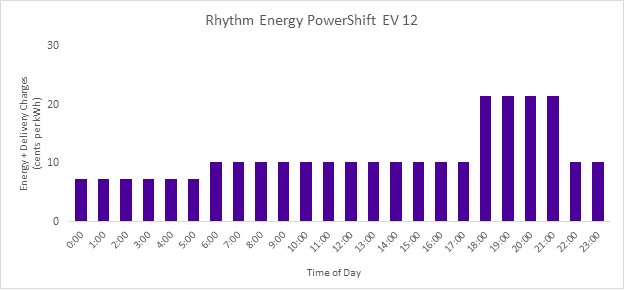
Knowing my usage, I’ve sized my battery to make sure it’s large enough to power my home through the evening hours in the hottest summer months, allowing me to get past 10pm without using the grid. Therefore, even though this plan’s average price for a typical user will be ~$0.12/kWh, I will likely only use it at night paying mostly the $0.07 rate. What the battery system allows you to do is to shop around for plans with the lowest nightly rates, ignoring high daytime or evening rates knowing that you’ll rarely need to use them. Also, if you have an EV like I do, you can use low nightly rates to charge your car conveniently and affordably overnight.
Speaking of EVs, let’s quickly talk about how to handle EV’s with solar and why Time of Use plans are useful there. First thing to understand is that when an EV is plugged in to charge, it is likely the biggest load in your home, and instead of running intermittently like your A/C, it could charge at that rate for hours at end. Like they say, a picture is worth a thousand words, so here’s one day of Bobrek Household consumption in August, that included using the oven (purple) in the afternoon and running the dishwasher (orange) at night. Notice the A/C cycling in blue (I have upstairs and downstairs units, which is why you see two tiers of consumption) and just how much EV charging dominates usage (in red) on days it’s being charged.
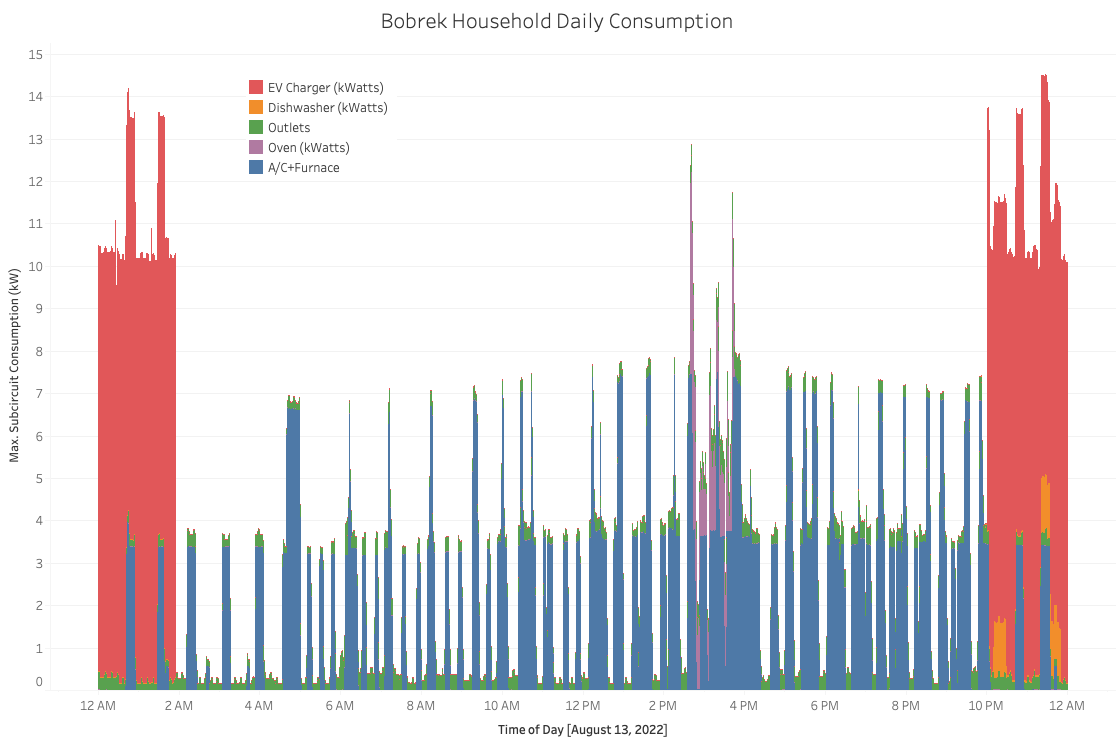
You can imagine several strategies on how to handle EVs with solar:
Plug your EV in during the day when you have excess solar. This requires you to charge in the middle of the day at home, which is not convenient for me, but it might work for you. Also, it requires you to size up your solar panels big enough to cover your home and your EV in the summer, leaving those panels to be over-generating on days you’re not charging.
Let your home batteries soak up excess solar and then charge your EV from them later. The problem with this is that EV battery packs are HUGE compared to home batteries. For example, a typical Tesla car energy capacity is equivalent to about 5-6 Tesla Powerwall home batteries. My Rivian R1T’s capacity is equivalent to 10 Powerwalls! For this strategy to work, you’d either need to spend a lot of money on home batteries or charge your EV in short spurts.
Let your solar + home battery system handle your house load and use those cheap Time of Use night hours to charge your EV.
Obviously from the graph above you can see I chose option #3, but your (EV charging) mileage may vary.
One final note on Time of Use plans, I’ve calculated that with my total investment in panels + batteries, for the entire lifecycle of the project, my equivalent cost is about $0.08/kWh of generated electricity. Although I pulled the above Time of Use prices on a random day (August 15, 2023) and they will shift, you can see that solar systems can’t necessarily beat cheap night time electricity, even with delivery charges included. However, solar cost is significantly cheaper than daytime/evening peak rates, which reinforces the idea that you should complement your solar systems with grid usage through a good Time of Use plan. I’d like to leave you with the following conclusions:
If you size your solar and battery installation right, you can cover most expensive hours of the day, allowing you to pick among various Time of Use plans and only use electricity in off peak hours. It will expose you to the cheapest electricity on the market, while maximizing the economic value of your solar system.
If you have an EV, it likely draws much more than your house, making it almost always better to charge off the grid than off your solar system. It’s another reason to find a good night time rate to complement your solar install.
Your financing and installation experience will vary…here’s mine
In this last section, I’m going to talk about what my experience was like finding the best way to pay for the project and the process of getting everything installed. This is not going to be a comprehensive overview of financing options; I think you can find some good material on the internet about secured vs unsecured solar loans, power purchase agreements (PPA), solar leases, etc. Instead, I will simply share what my logic was with the choices I made.
First, I knew I wanted to own my system, for two reasons: 1) that’s the only way to take advantage of the new 30% federal solar incentives and 2) I thought it would be simpler to sell an owned system with the home than try to get out of a lease or a PPA if we ever move. Therefore, the question was simply the best way to pay for it. One nice thing about the federal tax credit is that the government will take 30% of the project costs off your taxes, although you will have to wait until April the following year to get it. Therefore, I knew I was going to put at least 30% down because I would get it right back in a short time.
At the time I was shopping for solar loans, the rates were right around 7%, making it worthwhile to consider if I should put more money down or perhaps even pay some points to bring down the interest rate. A word of caution here, as I’ve seen marketing techniques to set up your solar loan in a way to ensure your solar monthly loan payment is less than your energy bill today, so you can see obvious savings immediately. In a higher interest rate environment, that’s most easily done by buying down your rate with points but increasing the amount you borrow. This is fine, but just be aware that you will owe more than the cost of your system early in the loan and that puts even more pressure on you staying in your house longer (most solar loans I’ve seen require loan repayment on sale of home).
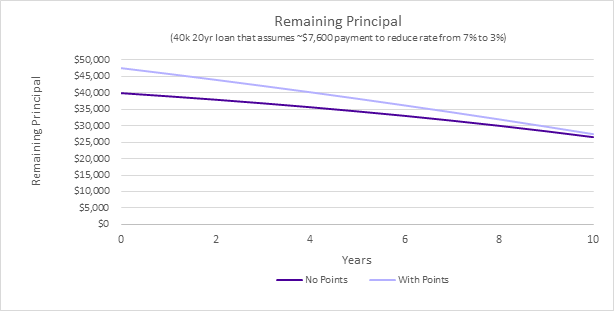
Source: Bankrate mortgage calculator
Above is a concrete example where a $40k 20-year loan has had its APR reduced from 7% to 3% with a $7,600 points payment (just some rough assumptions I found on the internet using a mortgage calculator). It shows that it will take 10 years to bring the principal owed of the two loans to a similar level. Selling the home in the first 2-3 years would require you to pay off a big chunk of the $7,600 without experiencing the benefit of a lower APR you paid for.
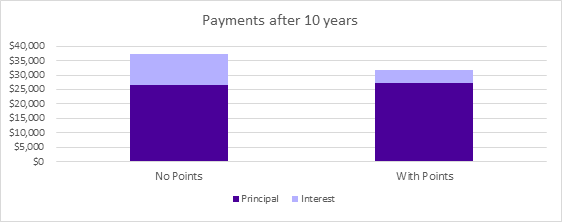
However, if you managed to stick it out for 10 years, you already get a benefit of the lower interest (see graph above). Over the whole 20yr period, the reduced APR (points) loan will cost you $63k in payments vs $74k for the higher APR loan. This isn’t any different than the decision on paying points for a home mortgage, so both approaches are reasonable depending on your personal situation, but I just wanted to highlight this scenario as it as it’s more relevant in the current higher interest rate environment. Second topic I would like to discuss is how my permitting and installation process has gone. The one bit of advice I can give here is that, just like any construction project, be prepared for things to be a bit unpredictable and take longer than expected. The major components of the installation process for me have been (roughly in order):
Engineering plan approval by the transmission and distribution utility for my area (CenterPoint for Houston)
Engineering plan approval by the City of Houston
Sourcing the components to start the work
Executing the installation
Inspection of completed project by the City of Houston
Permission to Operate (PTO) from CenterPoint, allowing you to connect your solar system to the grid
Coming into this project, I fully expected long wait times to get the PTO from CenterPoint. Last summer people were often waiting 90+ days to get them due to large number of projects; I got mine in 3 days this summer. On the other hand, I never heard about anyone running into issues with plan approval from the city’s planning department. That process took almost two months for me as my installer and the city were iterating on the plan, getting it just right to meet the City’s expectations. Bottom line is that there are a lot of moving pieces in getting this done, and many are out of the control of you or your installer. I found that having an installer that is responsive and a good communicator helps with these items. You can also accelerate things by staying on top of paperwork that is required from your end. Conclusions I wanted to leave you with in this section:
Do your research when it comes to paying for your solar system. There are a lot of financing options out there that allow you to acquire the system with very little money up front and with monthly payments similar to your electricity bill. However, be aware of the tradeoffs of your financing choices, especially if you’re not sure how long you’ll stay in your home.
Patience is the name of the game when it comes to getting your system permitted and installed. Select an installer that is responsive, experienced operating in your city, and has dedicated staff to both work the permitting and the installation parts of the project.
Conclusions
My solar system has been operating for a month now and I’m very pleased with how it’s working. Texas is currently experiencing record heat with frequent calls for energy conservation due to record electricity demand. It’s been a real benefit knowing that if there are rolling blackouts due to the overloaded grid, my home will not be affected. Also, since having the system installed, I’ve switched to a Time of Use plan that has significantly lowered the cost of my EV charging vs my previous plan. It’s still early and I’ve only had a few weeks of summer, but so far, my system has been behaving reasonably close to what I modeled, which is obviously a big relief. We’ll see how well my assumptions hold up over time.
I’m hoping that this article has been useful to you and that you’ve gotten some value from it. Obviously, your solar journey will likely be different. Every home has different usage profiles and capacity for panels; we haven’t even really talked about how your home is oriented, whether the roof is shaded or in clear weather, etc. Even with all those differences, I do feel that there are some universal lessons that everyone with solar should think about:
Even if you’re getting your solar to reduce your carbon footprint or have home backup, project economics are important in sizing the system optimally.
You should know your home’s energy usage and how it changes throughout the year to appropriately size your solar system.
Increased shift towards more solar energy usage will devalue selling your solar power back to the grid; instead, pair your solar panels with batteries so you can store that energy for later use in your home.
Utilize Time of Use plans to maximize the value of your system, allowing you to use cheap nighttime electricity from the grid while your solar and battery system handles your daytime and evening usage.
When financing your solar system, consider both the monthly payment and remaining principal to be paid, especially for cases when you’re uncertain how long you’ll be in your home.
Just like any construction project, expect twists and turns and occasional delays. Find a good installer that can effectively communicate to you what’s going on and what’s expected from you.
Let me leave you on the final thought about profitability of solar in Texas. In my modeling, I’ve found that the profitability is most tied to assumed price of electricity you will be getting from the grid, which shouldn’t be surprising. If electricity is very cheap over the next 10-15 years, solar may not be the best investment, but if the prices go up just a few cents per kWh, solar will pay off quickly…the sensitivity is remarkable. I’ve done most of my analysis using rates from this past spring, and with those assumptions I expect about 8-10 year payback period on my solar investment. However, the future is very difficult to predict, especially over longer periods of time. We are in the early stages of an energy transition which will likely stress our grid with growing pains. I expect that these growing pains will result in some periods of higher than normal prices or service instability over next decade, and if that comes to pass, I would feel pretty good about my solar investment. Even though your personal situation and priorities might be different, I hope you got something out of following my personal journey. Best of luck on a solar journey of your own should you choose to undertake it.
--Alex B.

